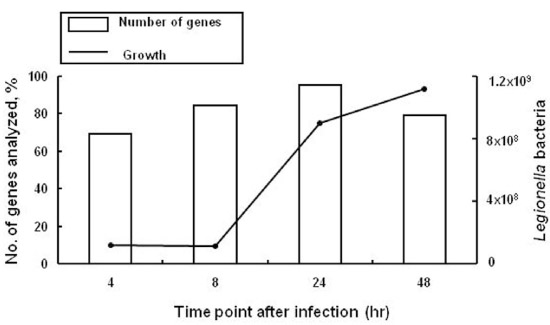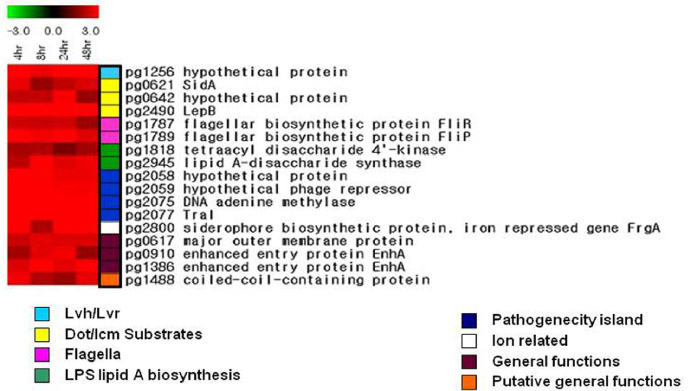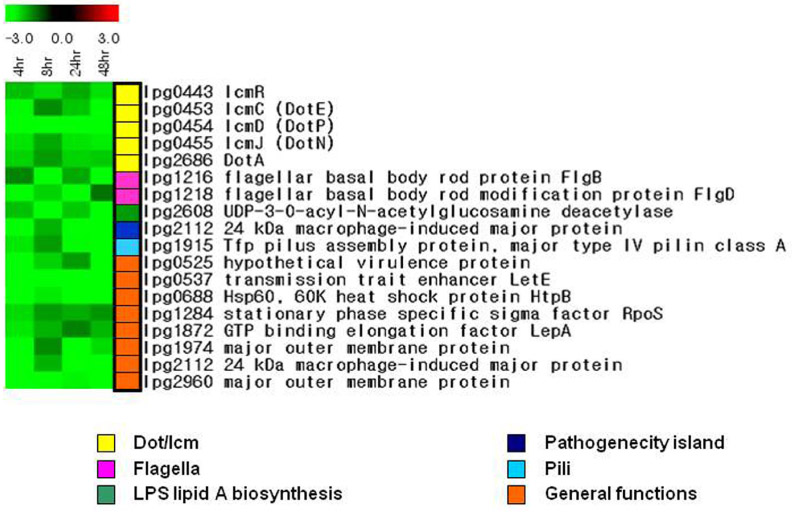Infect Chemother.
2010 Feb;42(1):23-29. 10.3947/ic.2010.42.1.23.
Discovery of Diagnostic Biomarkers for Legionnaires' Disease: Virulence Gene Expression Profiling of Legionella pneumophila serogroup 1 in A/J Mouse Model
- Affiliations
-
- 1BK21 Program of Graduate School, Korea University College of Medicine, Seoul, Korea. macropha@korea.ac.kr
- 2Division of Infectious Diseases, Korea University College of Medicine, Seoul, Korea.
- 3Research Institute of Emerging Infectious Diseases, Korea University, Seoul, Korea.
- KMID: 2170276
- DOI: http://doi.org/10.3947/ic.2010.42.1.23
Abstract
- BACKGROUND
Legionella pneumophila is the causative agent of Legionnaires' disease, a severe form of pneumonia. After L. pneumophila is inhaled through contaminated aerosols, it is phagocytized by alveolar macrophages, multiplies in a specialized phagosome approximately 10 h postinfection, and eventually leads to the death of host cells. Currently available diagnostic tests for Legionella pneumonia have some limitations. This study was conducted to find diagnostic biomarkers for Legionella pneumonia using virulence gene expression profiling in a murine experimental model.
MATERIALS AND METHODS
A/J mice were intranasally inoculated with L. pneumophila serogroup 1, and lungs were harvested 4, 8, 24, and 48 h postinfection. The strain grown in buffered yeast extract broth was used as reference samples. Cy-dye labeled cDNA samples were prepared with total RNA from lungs or broth culture, and hybridized on the oligo-microarray slide containing 2,895 genes of L. pneumophila serogroup 1. Virulence gene expression patterns were analyzed using a MIDAS software from TIGR (www.tigr.org).
RESULTS
Among a total of 332 virulence genes examined, 17 genes including sidA, lepB, the genes related to flagella assembly (fliR and fliP), LPS lipid A biosynthesis, and the enhanced entry protein EnhA were up-regulated at all four time points. We further confirmed by quantitative real-time reverse transcription PCR that the expression of fliP gene was highly expressed in lung tissue as well as in bronchoalveolar lavage fluids from the mouse infected with L. pneumophila serogroup 1.
CONCLUSIONS
Through gene expression analysis of L. pneumophila in a mouse model, several candidate biomarkers for diagnosing Legionnaires' disease could be identified.
Keyword
MeSH Terms
-
Aerosols
Animals
Biomarkers
Bronchoalveolar Lavage Fluid
Chimera
Diagnostic Tests, Routine
DNA, Complementary
Flagella
Gene Expression
Gene Expression Profiling
Legionella
Legionella pneumophila
Legionnaires' Disease
Lipid A
Lung
Macrophages, Alveolar
Mice
Oligonucleotide Array Sequence Analysis
Phagosomes
Pneumonia
Polymerase Chain Reaction
Reverse Transcription
RNA
Sprains and Strains
Yeasts
Aerosols
DNA, Complementary
Lipid A
RNA
Figure
Reference
-
1. Diederen BM. Legionella spp. and Legionnaires' disease. J Infect. 2008. 56:1–12.2. Steinert M, Heuner K, Buchrieser C, Albert-Weissenberger C, Glöckner G. Legionella pathogenicity: genome structure, regulatory networks and the host cell response. Int J Med Microbiol. 2007. 297:577–587.
Article3. Logan J, Edwards K, Saunders N. Real-time PCR: current technology and applications. 2009. 1st ed. London: Caister Academic Press;176.4. Ilyin SE, Belkowski SM, Plata-Salamán CR. Biomarker discovery and validation: technologies and integrative approaches. Trends Biotechnol. 2004. 22:411–416.
Article5. Brieland J, Freeman P, Kunkel R, Chrisp C, Hurley M, Fantone J, Engleberg C. Replicative Legionella pneumophila lung infection in intratracheally inoculated A/J mice. A murine model of human Legionnaires' disease. Am J Pathol. 1994. 145:1537–1546.6. Livak KJ, Schmittgen TD. Analysis of relative gene expression data using real-time quantitative PCR and the 2(-Delta Delta C(T)). Methods. 2001. 25(4):402–408.
Article7. Aoki S, Hirakata Y, Miyazaki Y, Izumikawa K, Yanagihara K, Tomono K, Yamada Y, Tashiro T, Kohno S, Kamihira S. Detection of Legionella DNA by PCR of whole-blood samples in a mouse model. J Med Microbiol. 2003. 52:325–329.
Article8. Brüggemann H, Cazalet C, Buchrieser C. Adaptation of Legionella pneumophila to the host environment: role of protein secretion, effectors and eukaryotic-like proteins. Curr Opin Microbiol. 2006. 9:86–94.
Article9. Segal G, Feldman M, Zusman T. The Icm/Dot type-IV secretion systems of Legionella pneumophila and Coxiella burnetii. FEMS Microbiol. 2005. 29:65–81.
Article10. De Buck E, Anné J, Lammertyn E. The role of protein secretion systems in the virulence of the intracellular pathogen Legionella pneumophila. Microbiology. 2007. 153:3948–3953.
Article11. Bachman MA, Swanson MS. The LetE protein enhances expression of multiple LetA/LetS-dependent transmission traits by Legionella pneumophila. Infect Immun. 2004. 72:3284–3293.
Article12. Brassinga AK, Hiltz MF, Sisson GR, Morash MG, Hill N, Garduno E, Edelstein PH, Garduno RA, Hoffman PS. A 65-kilobase pathogenicity island is unique to Philadelphia-1 strains of Legionella pneumophila. J Bacteriol. 2003. 185:4630–4637.
Article13. Brüggemann H, Hagman A, Jules M, Sismeiro O, Dillies MA, Gouyette C, Kunst F, Steinert M, Heuner K, Coppée JY, Buchrieser C. Virulence strategies for infecting phagocytes deduced from the in vivo transcriptional program of Legionella pneumophila. Cell Microbiol. 2006. 8:1228–1240.
Article14. Shin S, Roy CR. Host cell processes that influence the intracellular survival of Legionella pneumophila. Cell Microbiol. 2008. 10:1209–1220.
Article
- Full Text Links
- Actions
-
Cited
- CITED
-
- Close
- Share
- Similar articles
-
- Molecular Epidemiology of Legionella pneumophila Isolated from Bath Facilities of Public Establishments in Seoul
- A Case of Fatal Nosocomial Legionnaires' Disease by Legionella pneumophila Serogroup 1
- Isolation of the Legionella Species from Specimens of Cooling Tower Water
- A Case of Community-acquired Legionnaires' Disease in a Renal Transplant Recipient
- Community-acquired Legionnaires’ Disease in a Newly Constructed Apartment Building







